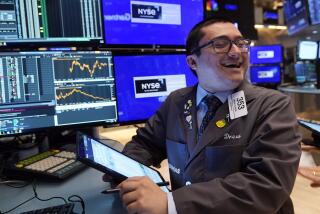BEDLAM ON WALL STREET : Borrowing Limit, Government Role : Dow Nose Dive Differs From Great ’29 Crash
NEW YORK — The stock market’s breathtaking plunge has evoked memories of the stock market crash of October, 1929, which burst the euphoria of a decade-long speculative bubble and foreshadowed the Great Depression.
But though the parallels seem to grow daily, economists and other analysts say the similarities are still far outweighed by the differences between the current decline and the debacle of 1929. Since the Great Crash, limits have been placed on borrowing for stock purchases, government has assumed an active role in regulating the markets and the economy, and nations have made greater efforts to minimize international economic disruptions.
Economy Stronger
Today’s economy is far stronger than the one that succumbed to depression within three years of the 1929 market dive.
To be sure, Monday’s drop in the Dow Jones industrial average has far overshadowed the losses suffered on Black Monday--Oct. 28, 1929--when the Dow lost 12.82% of its value. The index fell 508 points on Monday, to 1,738.74, for a 22.61% loss that astonished the gloomiest of market analysts.
Yet the market has a way to go to match the collapse that occurred between 1929 and 1932, when the market finally hit bottom. That decline represented nearly 90% of the Dow’s value; so far, the Dow has fallen 36.13% from its Aug. 25 peak of 2,722.42.
Even with Monday’s sell-off, the Dow is up 124% from its level in August, 1982, when the bull market began.
In fact, the Dow still has a way to go to match the losses of the 1973-74 market plunge, which still represents the sharpest decline since World War II. That market, troubled by runaway inflation, a volatile dollar and the loss of confidence in the U.S. government that followed Watergate, lost nearly 50% of its worth in that period, analysts note.
“The point drops of these recent sessions are shocking, but it’s important to remember that there have been other big falls too,” said Robert A. Cavesh, professor of finance at New York University.
The bull market of the 1980s never reached the dizzying heights of the 1920s market, when the Dow rose more than 500%. At the 1980s peak in August, the Dow had climbed nearly 250%.
Heavy Borrowing
The market boom of the 1920s was largely propelled by investors who borrowed heavily to purchase stocks, since the rules of the day required them to put down only 10% of the purchase price. This “margin” buying contributed heavily to the market’s collapse, for when prices fell, investors were required to come up with the money to cover their losses.
And when they could not, their stocks were sold, driving the market down further.
Investors are now required to put up at least 50% of a stock’s price. The Securities and Exchange Commission, which did not exist in 1929, sets rules to ensure that Wall Street firms have enough capital to make good their debts to investors if the market tumbles.
The firms are also insured to guarantee that they have enough money to pay off investors and keep a liquid market in securities. “There’s a whole elaborate system that’s developed over the years to monitor and regulate,” said Edward I. O’Brien, president of the Securities Industry Assn.
Government’s Role
The changed role of the government is dramatically reflected in the attitudes of the Federal Reserve Board. In 1929, the Federal Reserve, seeking to maintain the gold standard, took a passive role after the crash that allowed the money supply to contract nearly 30%, placing a further, heavier burden on the economy.
“Today the question is not whether the Fed should expand the money supply but by how much,” said James Lorie, a University of Chicago business professor.
Also underpinning the financial markets and the economy is the federal banking insurance system, which guarantees deposits in banks and savings and loans. Although banks have gone out of business regularly these days, a bank that failed in the 1920s, with no deposit insurance, had a far more devastating effect on the public, economists say.
The U.S. economy was expanding at the time of the Great Crash, but serious problems were also becoming apparent. In addition to bank failures, the agricultural sector and coal mining were seriously depressed. Unlike today, unemployment was high by historic levels, said John A. Garraty, professor of history at Columbia University and author of “The Great Depression.”
Although the economy’s expansion has been fitful in recent years, most analysts have expected a moderately healthy expansion of nearly 3% in the gross national product this year and a similar figure next year.
In 1929, nations were less inclined to cooperate with each other to try to maintain currency value and healthy trade relations, economists note.
The current market fall was set off in part by a United States dispute with the Germans and Japanese over the two nations’ plans to raise their interest rates in what U.S. officials considered a breach of an international understanding. But in 1929, economists say, the countries would not even have attempted to reach such an understanding.
The growing interdependence of the world’s economy, in some ways a threat to national economies, may also be a stabilizing factor, economists say. The interdependence might mean that, if one economy collapses, stronger trading partners will continue to offer a market for its goods and help its recovery.
Disturbing Developments
But, although these differences with 1929 are encouraging, other developments in the markets and the economy disturb many analysts.
Critics say relatively new securities and stock trading practices have increased the volatility of the market. Among them are so-called program trading, in which investors seek to exploit differences between the price of stock index futures and the prices of underlying stocks; and portfolio insurance, a recently developing hedging technique that calls for investors to sell more as prices drop.
Both practices hasten the fall of stocks in a declining market.
Critics have also found fault with the volatility involved in such inventions as stock index futures.
In buying these securities, investors bet on the future price of an average of several stocks. Although they are a means for big investors to offset the risk of a sharp rise or fall in their stock portfolios, “when I shift that risk off my back, I shift it to somebody else’s,” said Alan Bromberg, professor of securities law at Southern Methodist University in Dallas.
Many see big risks too in the American market’s dependence on foreign capital. Before the current sell-off began, foreign investors had $200 billion in New York Stock Exchange securities--about 8% of the total and a 38% increase from levels of 1985.
Experts say the withdrawal of even a modest share of the capital in the stock market can set off a sharp drop in stock prices.
“If these foreigners lose confidence in our markets, if they get spooked by the prospect of higher interest rates or a weaker dollar, we can be really hurt,” said Cavesh of NYU.
Although the U.S. market’s plunge was mirrored in markets elsewhere, Wall Street’s fall may be considered the first cause of the drop, “and that concerns me,” he said.
Many analysts see trouble too in the heavy levels of debt carried by the U.S. government, American corporations and consumers.
Those debts have soared to more than $9 trillion from $1 trillion in 1960, notes Lorie of the University of Chicago. The consumer portion of that debt increased tenfold over that period to $735 billion.
More to Read
Inside the business of entertainment
The Wide Shot brings you news, analysis and insights on everything from streaming wars to production — and what it all means for the future.
You may occasionally receive promotional content from the Los Angeles Times.











